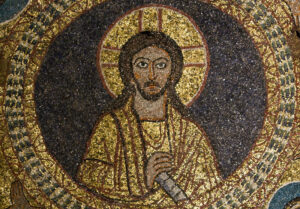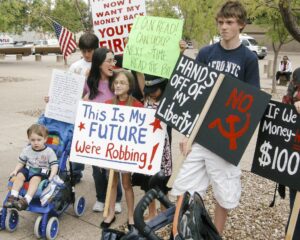Texas Governor Greg Abbott’s February 22 order, which targets transgender youth and their families for state persecution, is a clarion call for the church. As a community that embodies and proclaims a God of the oppressed, Christians must take a side with the most vulnerable and against the state—whatever the cost to our physical safety or cherished notions of unity.
How can Christians on the left stand in solidarity with our trans neighbors and siblings in Christ, particularly at a time when so many U.S. churches are complicit in denying them safety and dignity? I want to propose a few ideas, drawing from the examples of those who have gone before us with courage and clarity of purpose.
Speak clearly
Gov. Abbot’s recent order to investigate gender-affirming care for children as child abuse is hardly the first salvo against transgender people from the right. For the last few years, reactionary politicians and religious leaders have made their intentions toward transgender citizens perfectly clear. From the transgender bathroom panic to the anti-trans sports bills to the paranoia-inducing blitz in conservative media, the right has zeroed in on the LGBTQ+ community as its scapegoat of choice and is now waging a full-on legislative assault against the rights of transgender people to live and thrive as their authentic selves. Because Texas is the state with the second-most transgender residents in the U.S., the situation is especially dire.
Now is not the time for abstract theological platitudes or tepid political statements. If Christians are going to fight back, they must make their stance every bit as clear as the reactionary right. The emergence of a bellicose anti-trans agenda is partly the product of Christian timidity in advocating for the rights and dignity of trans life. Now, churches that are committed to the struggle to protect their trans neighbors must be utterly clear and transparent about their policies of LGBTQ+ inclusion.
One organization leading the way in demanding this transparency is Church Clarity, a volunteer-run organization that has been pushing churches to make their doctrines and policies around sex and gender crystal-clear to the public. Rooted in their conviction that “ambiguity enables those with power to operate without accountability and cause real harm,” in 2017 they established a website that maintains a growing crowd-sourced database of churches and their policies on LGBTQ+ inclusion, gender, leadership, marriage, and women in leadership. After someone submits a church to their database, the Church Clarity team assigns a score to the church, “based on how easy it is to find the church’s actively enforced policies on its website.”
I recently spoke with Spencer Noble, a volunteer leader and data entry lead for Church Clarity, about the importance of making church policy clear at a time like this.
Church Clarity is best known for publicizing and scoring the policies of evangelical megachurches, or what he calls “the style of church where they would say ‘all are welcome,’ but there are asterisks and footnotes.” Famously, the organization pressed for specifics from Hillsong Church in 2019, when it claimed to be “an inclusive Christian church” regardless of “personal identity.” In fact, the church had urged its members to vote against legalizing same-sex marriage in Australia in 2017 and had asked members of its leadership team to step down because they identified as gay in 2015.
Noble stressed that it’s important for LGBTQ+-affirming churches to spell out their policies too.
“There are churches that don’t know to be clear because they’ve never had to do that,” he said. Visitors to Church Clarity can request information about a church even if it doesn’t have an entry in their database yet, and while volunteers can research churches’ policies independently, churches also have the option of submitting their policies in writing.
Now more than ever, Noble stressed, trans people need to know which churches they can trust. Even churches with a progressive reputation need to spell it out. A trans person looking for a sanctuary needs more assurance than a rainbow flag on the front doors.
“You have to go beyond that in your actions,” Noble said. “A lot of that’s dependent on your local community. Are there active members of your community, of your church that this directly affects? Do you have trans members of the church [for whom] this directly affects their mental and emotional state? What do you do then?”
Provide sanctuary, defy the state
One of the most tangible ways churches can intervene in the struggle for trans protection is to throw open their doors as a sanctuary, defying the state when necessary. In fact, Christians and religious communities have been integral to the sanctuary movement, and we can find many powerful examples to draw on in the U.S.
Most recently, in September 2020 during an uprising after the police killing of Breonna Taylor, a Unitarian church in Louisville, Kentucky, provided sanctuary to protestors who were about to be arrested for breaking curfew. While police considered invading the church, Brother Tim Duncan told the press while standing under a Black Lives Matter banner, “It is a way of showing that we are with you.”
Ducan’s clear statement of solidarity in the face of a repressive state participates in a long history of making holy space safe for the oppressed. The Sanctuary movement of the 1980s, when churches in the American Southwest sheltered undocumented immigrants from Central America who were escaping violence and repression. Their movement openly defied President Reagan’s border policy, which nominally offered safety for asylum seekers while turning down massive numbers of asylum claims, often caging or deporting those fleeing violence.
The Sanctuary movement drew on ancient traditions of religious believers providing shelter in houses of worship. Southside Presbyterian Church in Tucson, Arizona, which provided aid and sanctuary to more than 13,000 migrants, invokes a long lineage on its website dating back to the ancient Hebrew cities of refuge, fugitive refuges in churches during the late Roman empire, and the Underground Railroad, which provided safe passage to fugitives fleeing enslavement on Southern plantations.
Founding leaders of the Sanctuary movement eventually expanded their work of care and radical hospitality beyond the walls of the church. In 2019, during the Trump administration’s aggressive expansion of the U.S. deportation regime, four humanitarian aid volunteers with the immigrant advocacy group No More Deaths/No Más Muertes faced federal charges for the crime of leaving jugs of water in the Arizona desert. They defied the law to protect human life at dangerous border crossings, paying the price for it — and in the process bringing the cruelty of U.S. immigration policy into the glaring light of day. This is another way of bearing witness.
The Rev. John Fife, who helped start the Sanctuary movement and continues to work with the No More Deaths ministry, spoke about the role of the church on both sides of the border in April 2019: “What does it mean to be the church in all this chaos?” he said. “I think the answer is simple: We provide care and protection for the most vulnerable people in this border region.”
In the U.S., the sanctuary church movement for migrants preceded the rise of sanctuary cities. In Berkeley, California, for instance, five local churches announced their status as sanctuaries on the same day as Tucson’s Southside Presbyterian in a 1982 declaration. They carefully organized, consulted with theologians and lawyers, and stood together to make their announcement. They provided the impetus for a movement that spread beyond Berkeley, inspiring hundreds of congregations nationwide to create a network inspired by the Underground Railroad. Following the Berkeley City Council’s vote to declare the entire city a sanctuary in 1985, the momentum begun by local congregants and clergy continued to build, and other municipal governments began to establish similar protections.
This time, in light of Gov. Abbott’s order, some of our churches will have to play catchup. Already plenty of clergy have resoundingly condemned Abbot’s insidious letter, and secular leaders, including prosecutors in some of Texas’ largest counties, have stood firm in saying “No” to Gov. Abbott’s order.
But leftist Christians need to push their churches to go beyond spiritual refusals of transphobia; a material challenge must also be mounted. Set up a trans healthcare fund; pay for medical care and counseling; find ways to partner with trans healthcare and advocacy organizations who are already doing the work. Like the Sanctuary churches of the 1980s, organize and educate your congregation on the why and the how of resistance. This is not the first or the last attack, and we will need strong bonds of fellowship and mutual aid to build material alternatives in the face of violent state action.
Testify
Provide space in your worship service or community meetings to name and lament the evil being done in the name of Christ’s church. Proclaim the gospel over and against our oppressors. This proclamation must be clear that Jesus is in solidarity with trans people and not their oppressors. And his solidarity must become ours. As Melissa Florer-Bixler writes in her recent book, How to Have an Enemy, “The good news of Jesus Christ is only good news when it proclaims that we will overcome enmity by aligning ourselves with others who reject the principalities and powers of the old age, knowing this will set us all free.”
There are a number of direct actions your church can bring to bear. Go to Statehouse hearings with your church and speak. Go to the governor’s mansion and bang a drum. Those of us in church communities have strength in numbers, and we are used to raising our voices together. Carefully consider what it will take to wield the considerable force of the church in a spiritual and material struggle against the powers of our age.
Successful resistance will require more than an activist stance, though, more than a one-time campaign against a particularly odious bill or executive order. It will require churches to provide their own forms of political education, strengthen their networks of social bonds, and develop an analysis of where reaction and apathy are strongest in our congregations and institutions. To defeat creeping Christofascism, we will have to get organized. For the sake of our trans neighbors, out-organizing the right is not just an option, it is a matter of survival.
A sanctuary for trans lives
Last year, I spoke with Pastor Jim Conrad of Towne View Baptist Church in Kennesaw, Georgia. At the time, his Southern Baptist congregation had made national news after deciding to accept and affirm LGBTQ+ people as full members. They were promptly booted out of the Southern Baptist Convention as a result.
When we spoke, Pastor Conrad was coming out of a season of turmoil. One-third of his congregation had left, and he had lost the support of the largest Protestant denomination in the U.S. But when we spoke, his voice conveyed pure joy. He told me how, at a recent anniversary celebration for his church, he had welcomed new members including young children, a gay couple, and a trans woman making her first appearance as her authentic self in front of the congregation.
“We feel privileged that these folks in this community feel safe and welcomed,” he said.
I realized he was describing a holy moment in a very real sanctuary. Part of the work of the church is to consecrate and celebrate its members at vital junctures in their lives. To call someone by a new name, dignifying them as they go forth in the eyes of God and the community — this, too, is an ancient tradition. In the coming weeks, boldly proclaim the beauty and the image of God in our trans friends. Build and create spaces where trans people can live and thrive. Go with power and grace, and without fear.
Paul Bowers writes about education, class struggle, and brutalist architecture in the American South at brutalsouth.substack.com. He lives in North Charleston, S.C.




